Link Connectivity and Coverage of Underwater Cognitive Acoustic Networks under Spectrum Constraint
Abstract
:1. Introduction
- We develop a novel analytical model to investigate the link connectivity and the coverage probability of SUs in UCANs. We find that the link connectivity and coverage of SUs depends on both the spectrum availability and the topological connectivity, while the spectrum availability has been ignored in most existing works.
- We conduct extensive simulations to verify the accuracy of our proposed model. The simulation results match the analytical results, implying that our proposed model is fairly accurate.
- We observe that the probability of connectivity and the probability of coverage are affected by acoustic signal frequency, various ambient factors (spreading factor and wind speed), and the activity of PUs. Our results also offer some useful insights in designing QoS-aware UCANs.
2. Related Works
3. System Model
3.1. Problem Definition
3.2. Network Model
3.3. Channel Model
4. Analysis of Link Connectivity and Probability of Coverage
- (1)
- Both of the SUs can connect topologically;
- (2)
- Both of the SUs have the spectrum.
4.1. Topological Connection Condition
4.2. Spectrum Availability
- (1)
- No PUs in the detection region of SU1;
- (2)
- No PUs in the detection region of SU2.
4.3. Link Connectivity
4.4. Probability of Coverage
5. Simulations
5.1. Simulation Method
5.2. Probability of Connection
5.2.1. Impacts of Ambient Environment
5.2.2. Impacts of PUs
5.3. Probability of Coverage
5.4. Discussion and Future Works
6. Conclusions
Acknowledgments
Author Contributions
Conflicts of Interest
Appendix A. Attenuation
Appendix B. Ambient Noise
References
- Luo, Y.; Pu, L.; Zuba, M.; Peng, Z.; Cui, J.H. Challenges and opportunities of underwater cognitive acoustic networks. IEEE Trans. Emerg. Top. Comput. 2014, 2, 198–211. [Google Scholar] [CrossRef]
- Wang, H.; Osen, O.; Li, G.; Li, W.; Dai, H.N.; Zeng, W. Big Data and Industrial Internet of Things for the Maritime Industry in Northwestern Norway. In Proceedings of the IEEE Region 10 Conference (TENCON), Macao, China, 1–4 November 2015. [Google Scholar]
- Lloret, J.; Garcia, M.; Sendra, S.; Lloret, G. An underwater wireless group-based sensor network for marine fish farms sustainability monitoring. Telecommun. Syst. 2015, 60, 67–84. [Google Scholar] [CrossRef]
- Luo, Y.; Pu, L.; Peng, Z.; Zhu, Y.; Cui, J.H. RISM: An efficient spectrum management system for underwater cognitive acoustic networks. In Proceedings of the 2014 Eleventh Annual IEEE International Conference on Sensing, Communication, and Networking (SECON), Singapore, 30 June–3 July 2014; pp. 414–422. [Google Scholar]
- Li, X.; Sun, Y.; Guo, Y.; Fu, X.; Pan, M. Dolphins First: Dolphin-Aware Communications in Multi-Hop Underwater Cognitive Acoustic Networks. IEEE Trans. Wirel. Commun. 2017, 16, 2043–2056. [Google Scholar] [CrossRef]
- Wang, D.; Zhang, Y.; Hu, X.; Zhang, R.; Su, W.; Xie, Y. A dynamic spectrum decision algorithm for underwater cognitive acoustic networks. In Proceedings of the 11th ACM International Conference on Underwater Networks & Systems, Shanghai, China, 24–26 October 2016; ACM: New York, NY, USA, 2016; p. 3. [Google Scholar]
- Luo, Y.; Pu, L.; Mo, H.; Zhu, Y.; Peng, Z.; Cui, J.H. Receiver-initiated spectrum management for underwater cognitive acoustic network. IEEE Trans. Mob. Comput. 2017, 16, 198–212. [Google Scholar] [CrossRef]
- Pompili, D.; Melodia, T.; Akyildiz, I. Distributed Routing Algorithms for Underwater Acoustic Sensor Networks. IEEE Trans. Wirel. Commun. 2010, 9, 2934–2944. [Google Scholar] [CrossRef]
- Rahman, R.H.; Benson, C.; Frater, M. Routing Protocols for Underwater Ad Hoc Networks. In Proceedings of the IEEE Oceans, Yeosu, Korea, 21–24 May 2012. [Google Scholar]
- Lloret, J. Underwater Sensor Nodes and Networks. Sensors 2013, 13, 11782–11796. [Google Scholar] [CrossRef] [PubMed]
- Mandal, P.; De, S. New Reservation Multiaccess Protocols for Underwater Wireless Ad Hoc Sensor Networks. IEEE J. Ocean. Eng. 2015, 40, 277–291. [Google Scholar] [CrossRef]
- Javaid, N.; Jafri, M.R.; Ahmed, S.; Jamil, M.; Khan, Z.A.; Qasim, U.; Al-Saleh, S.S. Delay-Sensitive Routing Schemes for Underwater Acoustic Sensor Networks. Int. J. Distrib. Sens. Netw. 2015. [Google Scholar] [CrossRef]
- Ahmed, S.; Javaid, N.; Khan, F.A.; Durrani, M.Y.; Ali, A.; Shaukat, A.; Sandhu, M.M.; Khan, Z.A.; Qasim, U. Co-UWSN: Cooperative Energy-Efficient Protocol for Underwater WSNs. Int. J. Distrib. Sens. Netw. 2015, 2015. [Google Scholar] [CrossRef] [PubMed]
- Sendra, S.; Lloret, J.; Jimenez, J.M.; Rodrigues, J.J. Underwater Communications for Video Surveillance Systems at 2.4 GHz. Sensors 2016, 16, 1769. [Google Scholar] [CrossRef] [PubMed]
- Baldo, N.; Casari, P.; Zorzi, M. Cognitive Spectrum Access for Underwater Acoustic Communications. In Proceedings of the ICC Workshops—2008 IEEE International Conference on Communications Workshops, Beijing, China, 19–23 May 2008; pp. 518–523. [Google Scholar]
- Torres, D.; Charbiwala, Z.; Friedman, J.; Srivastava, M. Spectrum Signaling for Cognitive Underwater Acoustic Channel Allocation. In Proceedings of the INFOCOM IEEE Conference on Computer Communications Workshops, San Diego, CA, USA, 15–19 March 2010; pp. 1–6. [Google Scholar]
- Bicen, A.O.; Sahin, A.B.; Akan, O.B. Spectrum-aware Underwater Networks. IEEE Veh. Technol. Mag. 2012, 7, 34–40. [Google Scholar] [CrossRef]
- Wang, J.; Zhang, X.; Zhu, Q. Statistical QoS-Driven Power Adaptation over MIMO-GFDM Based Underwater Wireless Networks. In Proceedings of the 10th International Conference on Underwater Networks & Systems, WUWNET ’15, Arlington, VA, USA, 22–24 October 2015; ACM: New York, NY, USA, 2015. [Google Scholar]
- ElSawy, H.; Hossain, E.; Haenggi, M. Stochastic Geometry for Modeling, Analysis, and Design of Multi-Tier and Cognitive Cellular Wireless Networks: A Survey. IEEE Commun. Surv. Tutor. 2013, 15, 996–1019. [Google Scholar] [CrossRef]
- Andrews, J.G.; Baccelli, F.; Ganti, R.K. A Tractable Approach to Coverage and Rate in Cellular Networks. IEEE Trans. Commun. 2011, 59, 3122–3134. [Google Scholar] [CrossRef]
- Coates, R. Underwater Acoustic Systems; Palgrave Macmillan: Basingstoke, UK, 1990. [Google Scholar]
- Stojanovic, M. On the Relationship Between Capacity and Distance in an Underwater Acoustic Communication Channel. In Proceedings of the First Workshop on Underwater Networks, WUWNET 2006, Los Angeles, CA, USA, 25 September 2007. [Google Scholar]
- Lucani, D.; Medard, M.; Stojanovic, M. Capacity scaling laws for underwater networks. In Proceedings of the 42nd Asilomar Conference on Signals, Systems and Computers, Pacific Grove, CA, USA, 26–29 October 2008; pp. 2125–2129. [Google Scholar]
- Zhang, W.; Stojanovic, M.; Mitra, U. Analysis of a Linear Multihop Underwater Acoustic Network. IEEE J. Ocean. Eng. 2010, 35, 961–970. [Google Scholar] [CrossRef]
- Domingo, M.C. Securing Underwater Wireless Communication Networks. IEEE Wirel. Commun. 2011, 18, 22–28. [Google Scholar] [CrossRef]
- Gao, M.; Foh, C.H.; Cai, J. On the Selection of Transmission Range in Underwater Acoustic Sensor Networks. Sensors 2012, 12, 4715–4729. [Google Scholar] [CrossRef] [PubMed]
- Shin, W.Y.; Lucani, D.E.; Médard, M.; Stojanovic, M.; Tarokh, V. On the Effects of Frequency Scaling over Capacity Scaling in Underwater Networks—Part I: Extended Network Model. Wirel. Pers. Commun. 2013, 71, 1683–1700. [Google Scholar] [CrossRef]
- Shin, W.Y.; Lucani, D.E.; Médard, M.; Stojanovic, M.; Tarokh, V. On the Effects of Frequency Scaling over Capacity Scaling in Underwater Networks—Part II: Dense Network Model. Wirel. Pers. Commun. 2013, 71, 1701–1719. [Google Scholar] [CrossRef]
- Wang, Q.; Dai, H.-N.; Li, X.; Wang, H.; Xiao, H. On Modeling Eavesdropping Attacks in Underwater Acoustic Sensor Networks. Sensors 2016, 16, 721. [Google Scholar] [CrossRef] [PubMed]
- Rabbachin, A.; Quek, T.Q.S.; Shin, H.; Win, M.Z. Cognitive Network Interference. IEEE J. Sel. Areas Commun. 2011, 29, 480–493. [Google Scholar] [CrossRef]
- Bettstetter, C. On the Connectivity of Ad Hoc Networks. Comput. J. 2004, 47, 432–447. [Google Scholar] [CrossRef]
- Zhou, X.; Durrani, S.; Jones, H. Connectivity Analysis of Wireless Ad Hoc Networks with Beamforming. IEEE Trans. Veh. Technol. 2009, 58, 5247–5257. [Google Scholar] [CrossRef]
- Lee, S.; Zhang, R.; Huang, K. Opportunistic Wireless Energy Harvesting in Cognitive Radio Networks. IEEE Trans. Wirel. Commun. 2013, 12, 4788–4799. [Google Scholar] [CrossRef]
- Coutinho, R.W.L.; Boukerche, A.; Vieira, L.F.M.; Loureiro, A.A.F. Geographic and Opportunistic Routing for Underwater Sensor Networks. IEEE Trans. Comput. 2016, 65, 548–561. [Google Scholar] [CrossRef]
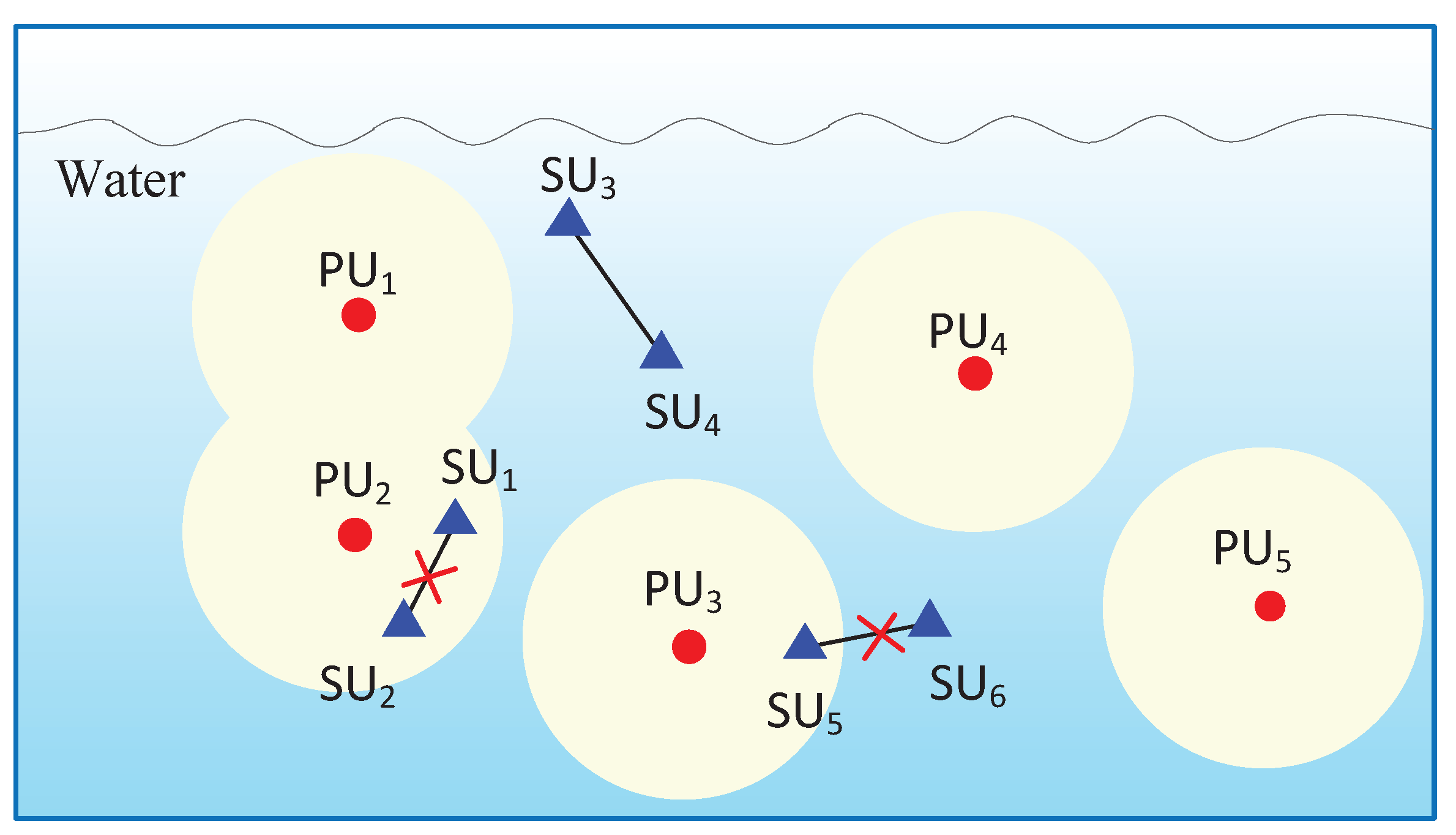
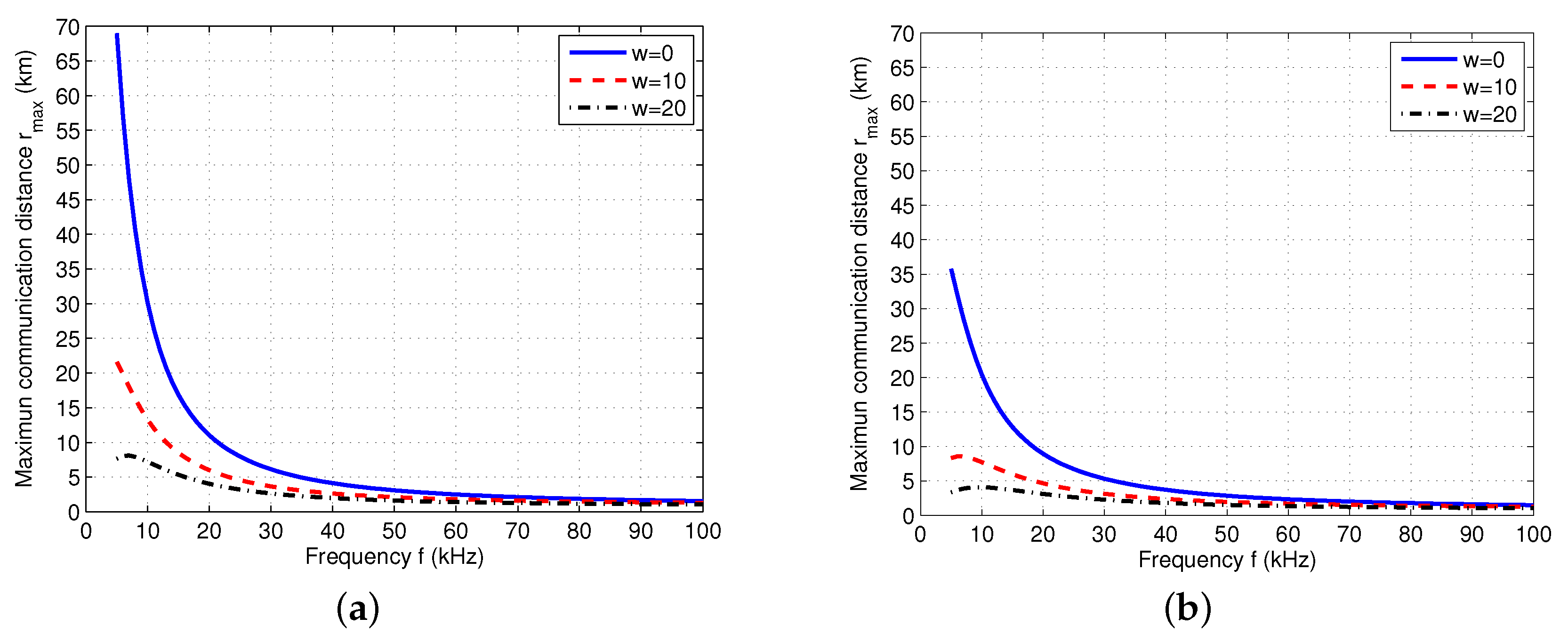
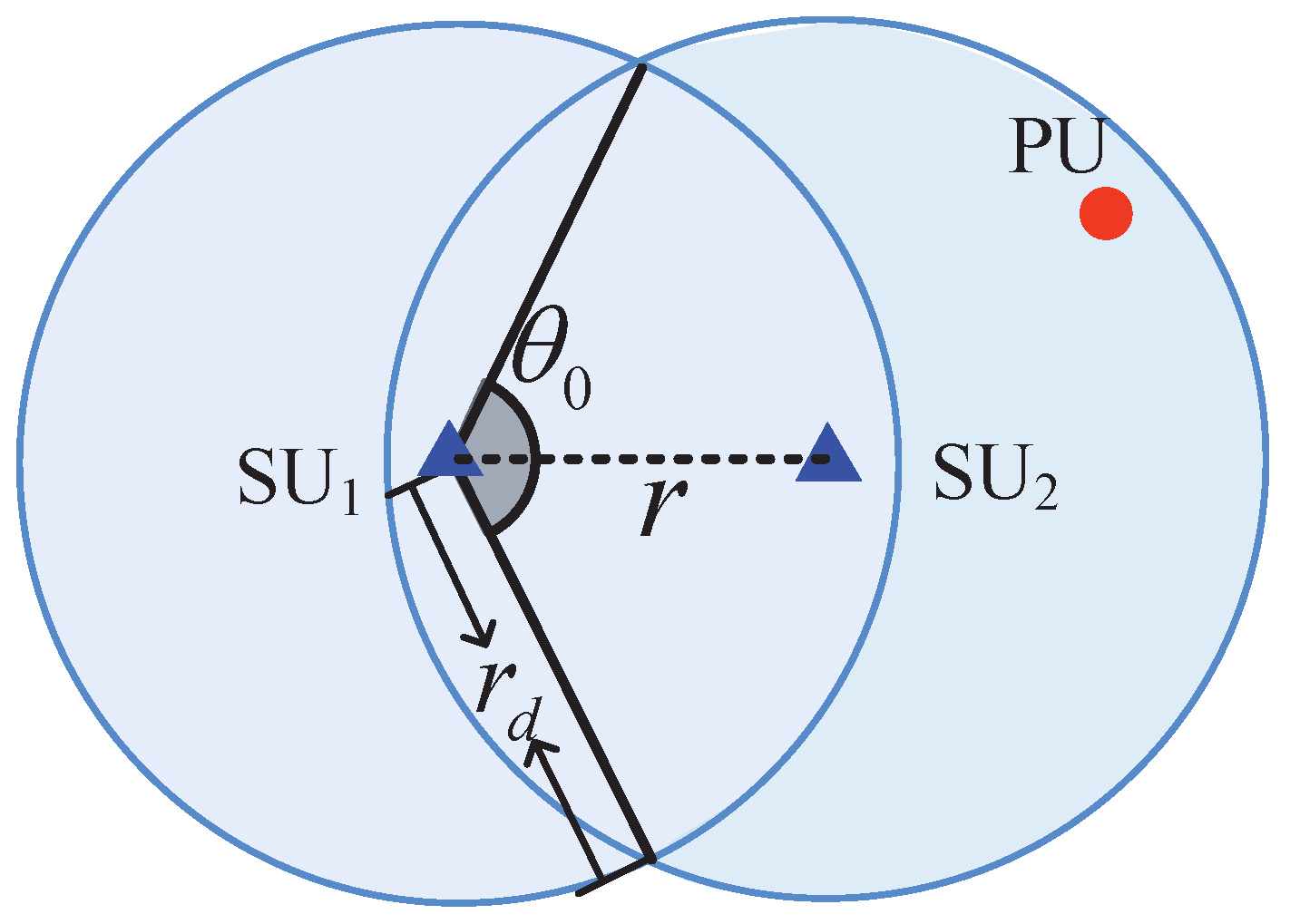
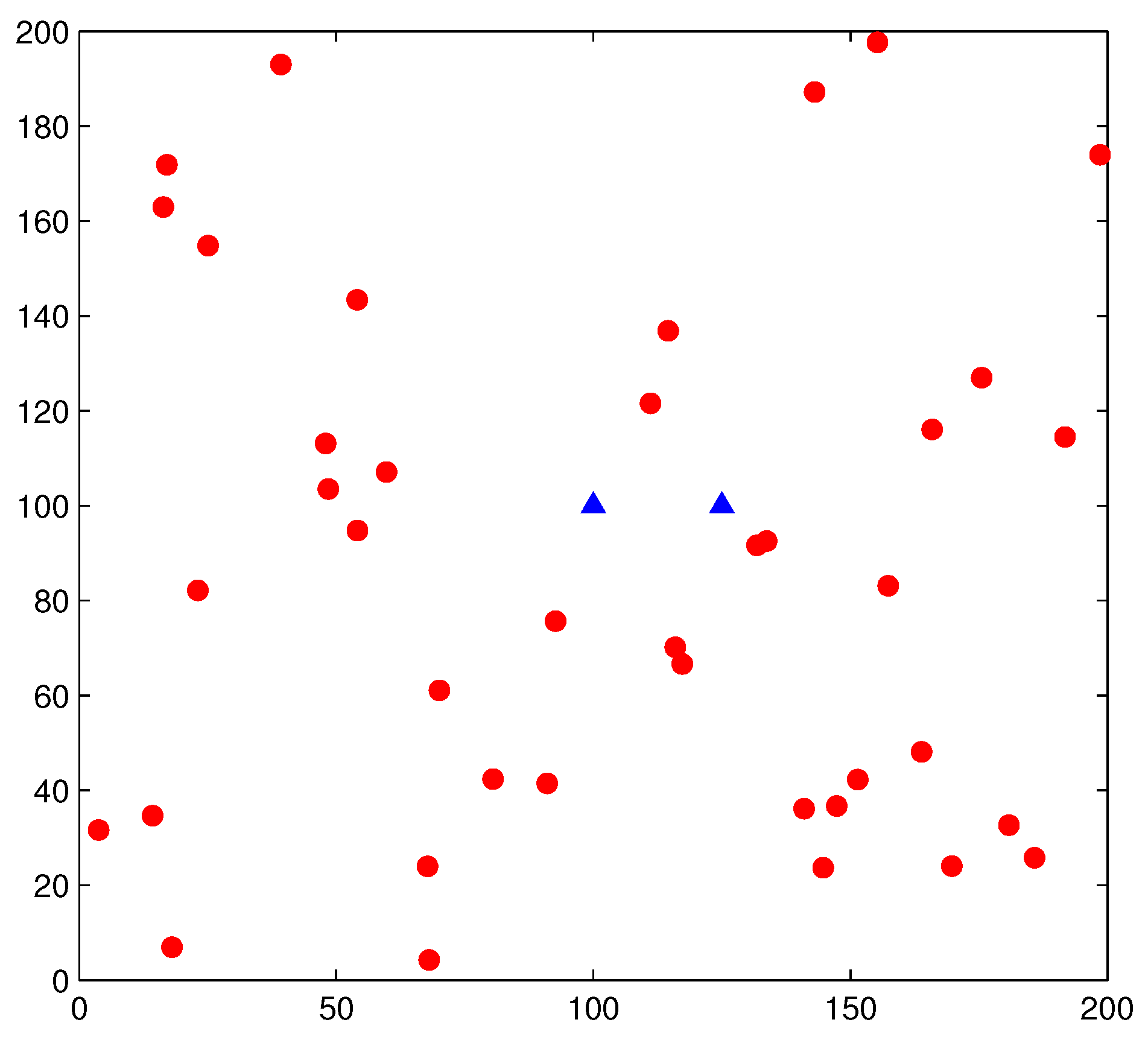
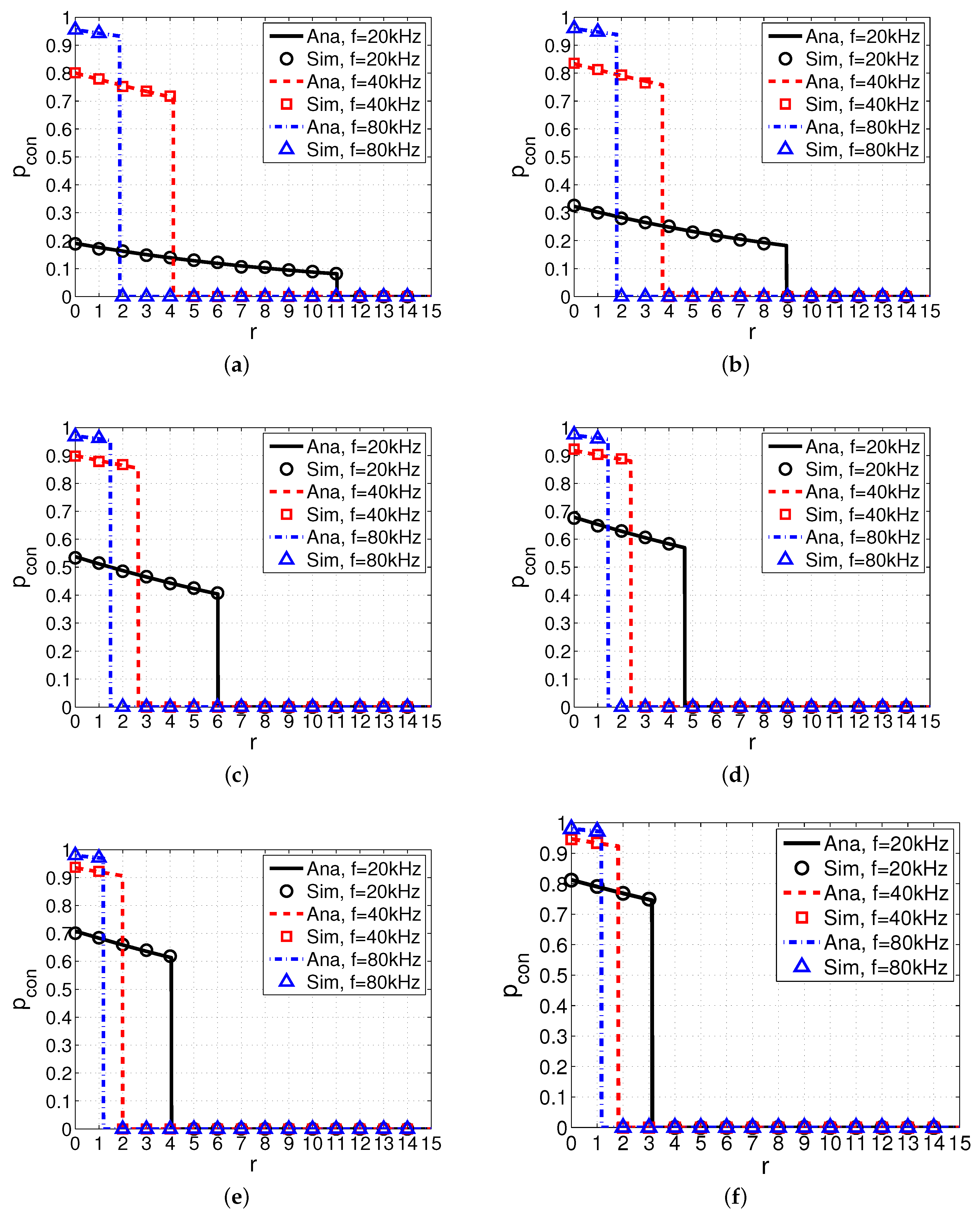
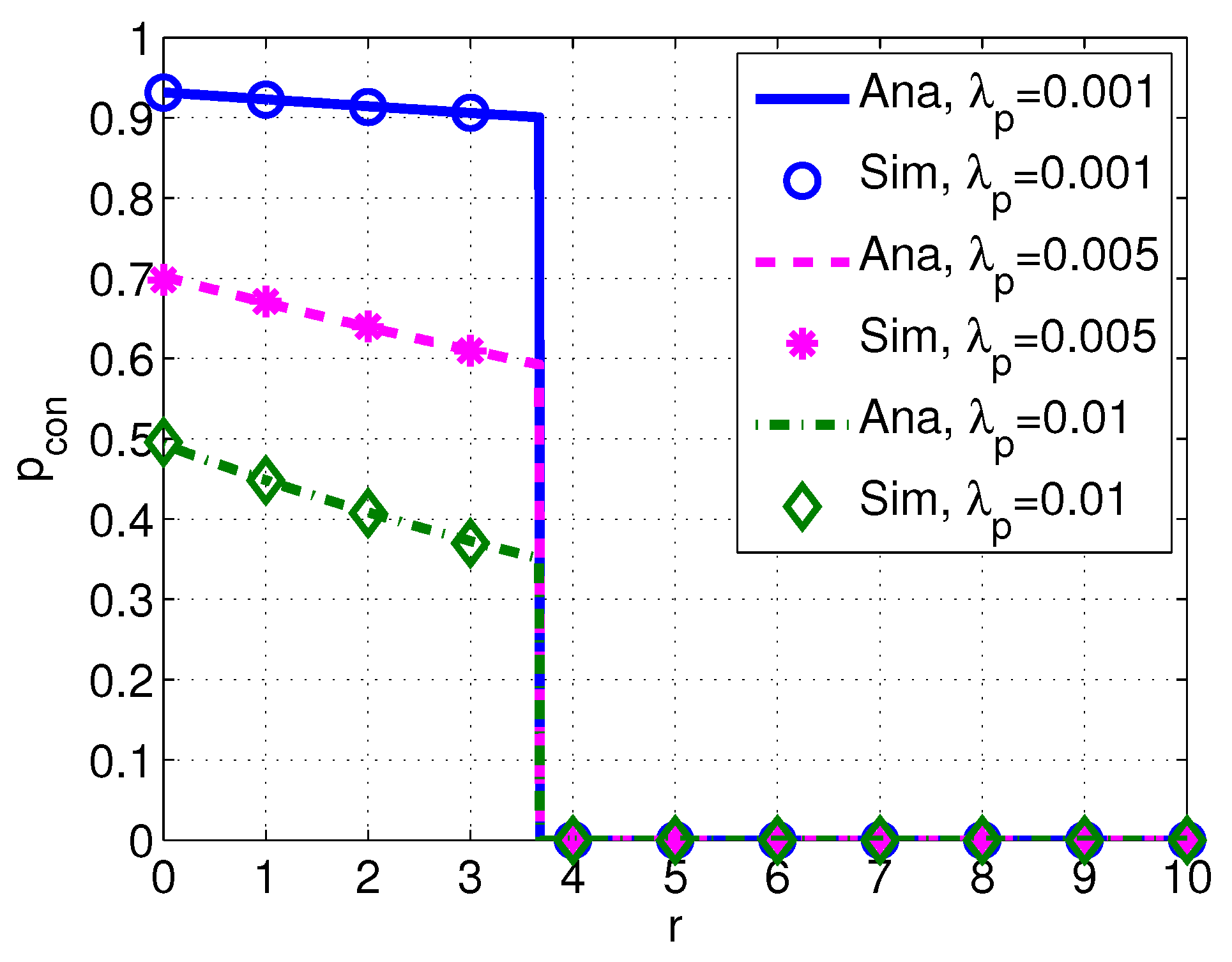
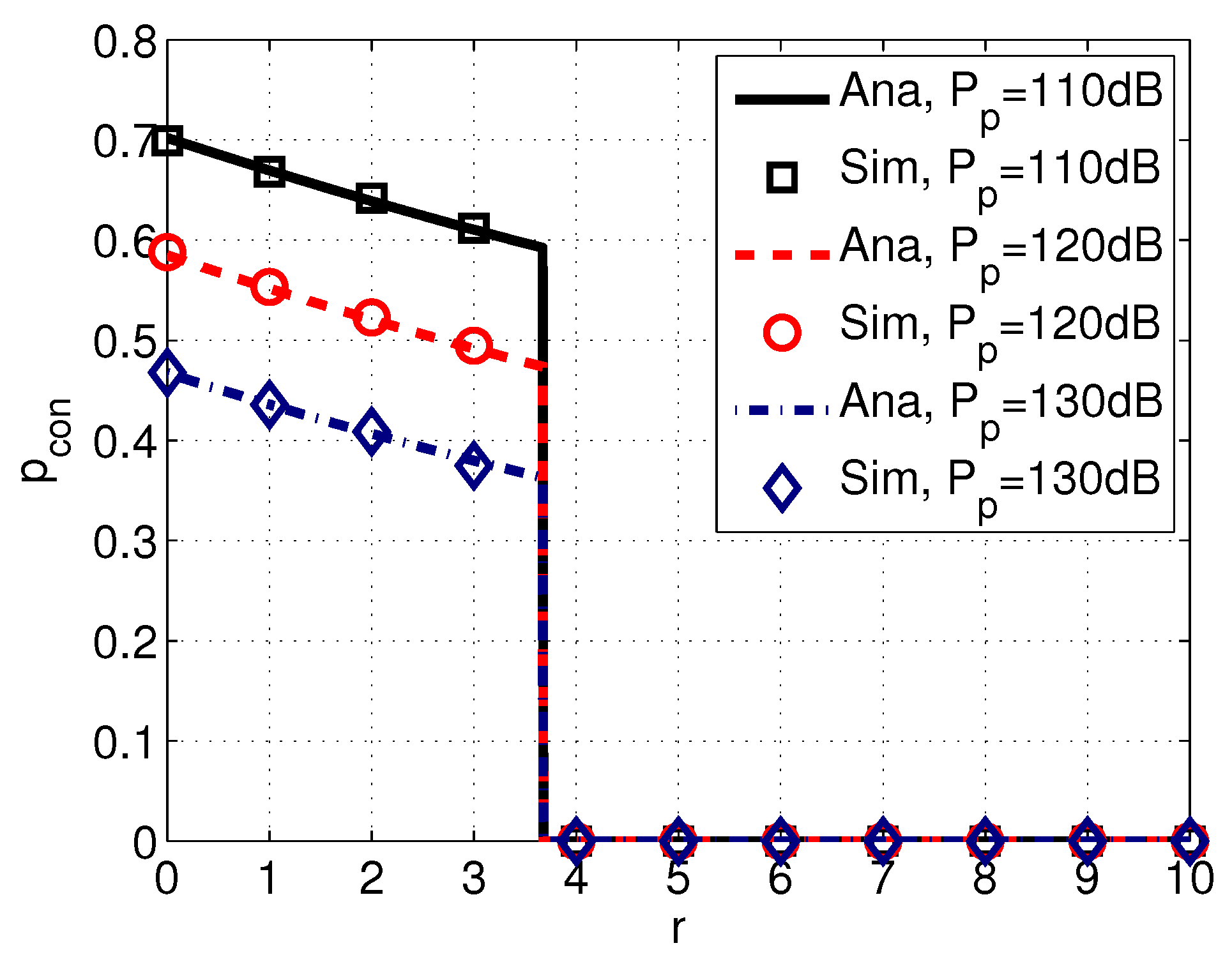
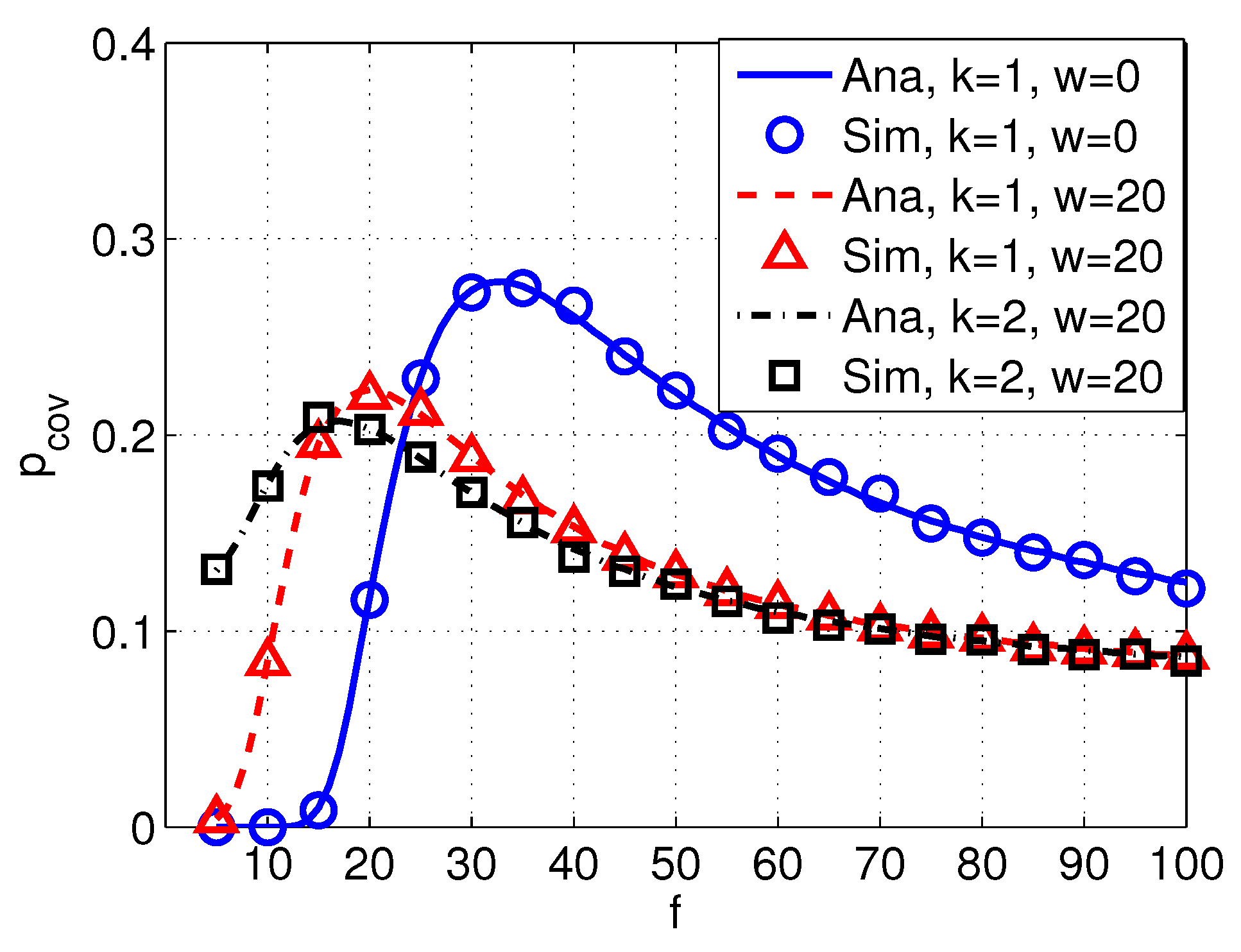
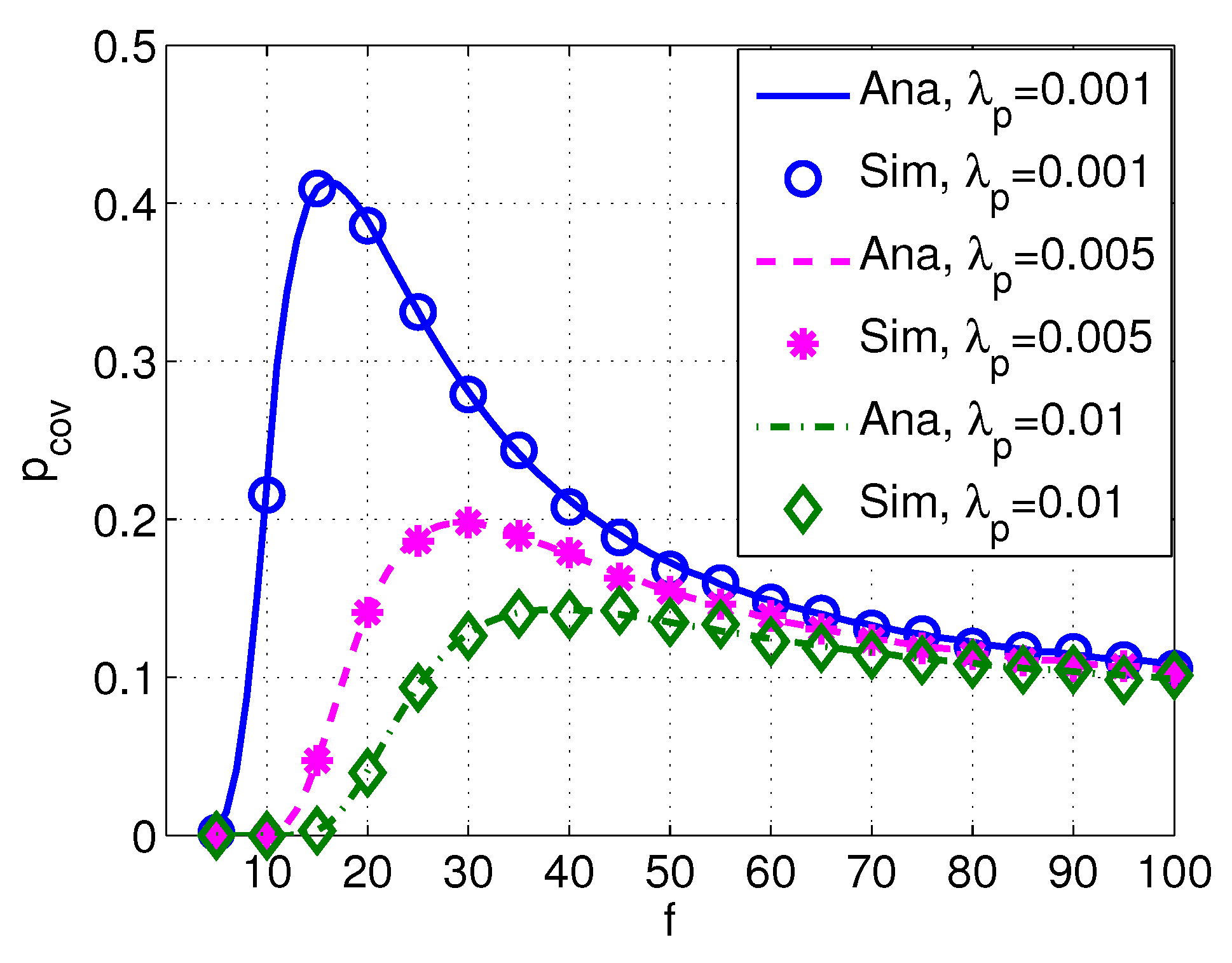
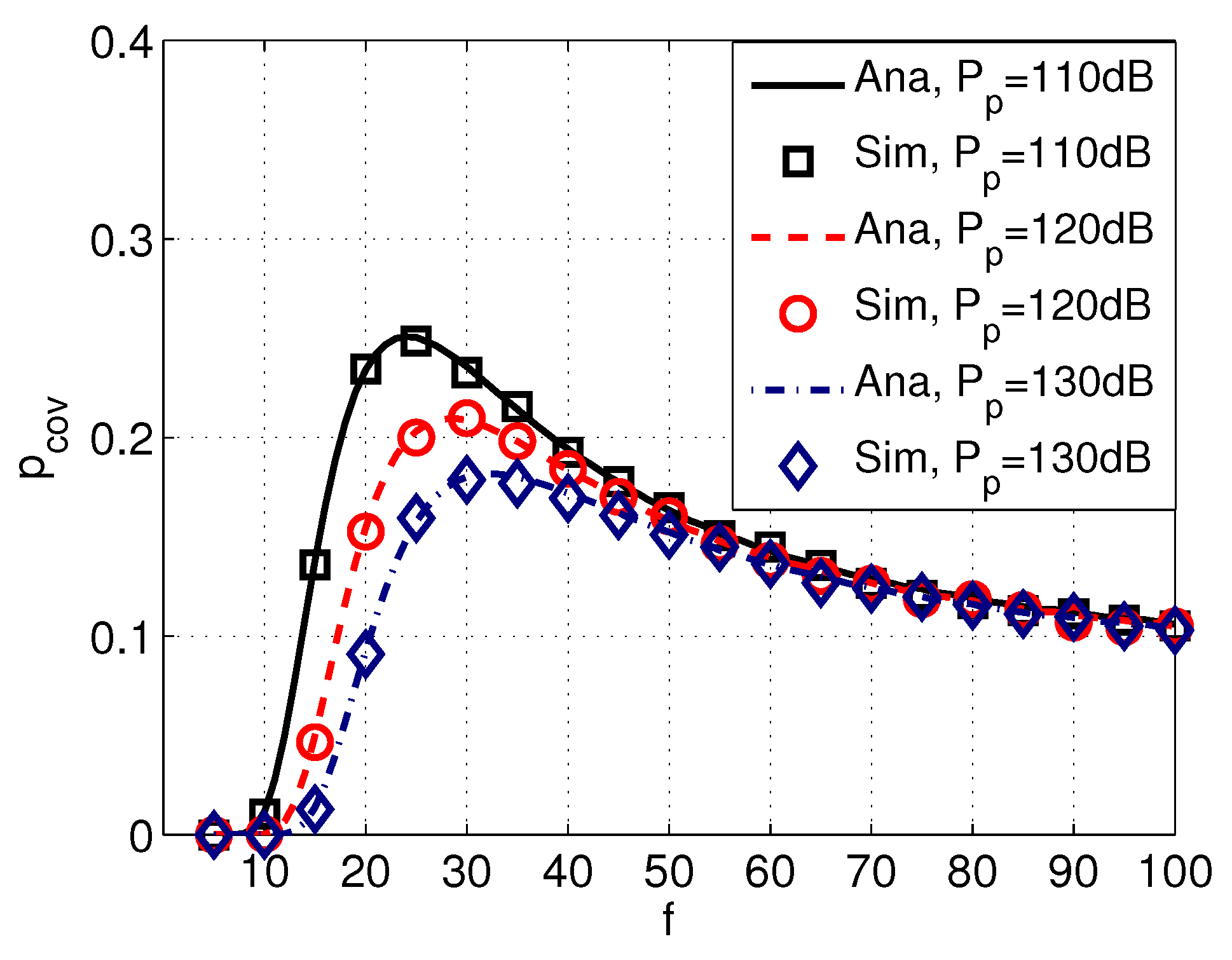
| Analytical Value | Simulation Value with Ω = 500 | Simulation Value with Ω = 20,000 | |
|---|---|---|---|
| r = 1 km | 0.1758 | 0.1520 (13.53%) | 0.1726 (0.18%) |
| r = 2 km | 0.1624 | 0.1640 (0.99%) | 0.1612 (0.74%) |
| r = 3 km | 0.1500 | 0.1560 (4.00%) | 0.1454 (3.07%) |
| r = 4 km | 0.1386 | 0.1180 (14.86%) | 0.1417 (2.24%) |
| Average deviation | 8.35% | 1.56% | |
© 2017 by the authors. Licensee MDPI, Basel, Switzerland. This article is an open access article distributed under the terms and conditions of the Creative Commons Attribution (CC BY) license (http://creativecommons.org/licenses/by/4.0/).
Share and Cite
Wang, Q.; Dai, H.-N.; Cheang, C.F.; Wang, H. Link Connectivity and Coverage of Underwater Cognitive Acoustic Networks under Spectrum Constraint. Sensors 2017, 17, 2839. https://doi.org/10.3390/s17122839
Wang Q, Dai H-N, Cheang CF, Wang H. Link Connectivity and Coverage of Underwater Cognitive Acoustic Networks under Spectrum Constraint. Sensors. 2017; 17(12):2839. https://doi.org/10.3390/s17122839
Chicago/Turabian StyleWang, Qiu, Hong-Ning Dai, Chak Fong Cheang, and Hao Wang. 2017. "Link Connectivity and Coverage of Underwater Cognitive Acoustic Networks under Spectrum Constraint" Sensors 17, no. 12: 2839. https://doi.org/10.3390/s17122839






